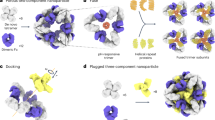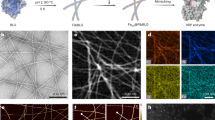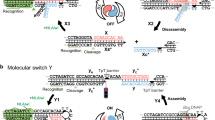Abstract
Supramolecular chemistry provides a versatile tool for the organization of molecular systems into functional structures and the actuation of these assemblies for applications through the reversible association between complementary components. Use of this methodology in living systems, however, represents a significant challenge owing to the chemical complexity of cellular environments and lack of selectivity of conventional supramolecular interactions. Herein, we present a host–guest system featuring diaminohexane-terminated gold nanoparticles (AuNP–NH2) and complementary cucurbit[7]uril (CB[7]). In this system, threading of CB[7] on the particle surface reduces the cytotoxicity of AuNP–NH2 through sequestration of the particle in endosomes. Intracellular triggering of the therapeutic effect of AuNP–NH2 was then achieved through the administration of 1-adamantylamine (ADA), removing CB[7] from the nanoparticle surface, causing the endosomal release and concomitant in situ cytotoxicity of AuNP–NH2. This supramolecular strategy for intracellular activation provides a new tool for potential therapeutic applications.
This is a preview of subscription content, access via your institution
Access options
Subscribe to this journal
Receive 12 print issues and online access
$259.00 per year
only $21.58 per issue
Buy this article
- Purchase on Springer Link
- Instant access to full article PDF
Prices may be subject to local taxes which are calculated during checkout





Similar content being viewed by others
References
Lehn, J.-M. Toward self-organization and complex matter. Science 295, 2400–2403 (2002).
Lehn, J.-M. From supramolecular chemistry towards constitutional dynamic chemistry and adaptive chemistry. Chem. Soc. Rev. 36, 151–160 (2007).
Reinhoudt, D. N. & Crego-Calama, M. Synthesis beyond the molecule. Science 295, 2403–2407 (2002).
Yaghi, O. M. et al. Reticular synthesis and the design of new materials. Nature 423, 705–714 (2003).
Lehn, J.-M. Supramolecular Chemistry: Concepts and Perspectives (VCH, 1995).
Dankers, P. Y. W., Harmsen, M. C., Brouwer, L. A., Van Luyn, M. J. A. & Meijer, E. W. A modular and supramolecular approach to bioactive scaffolds for tissue engineering. Nature Mater. 4, 568–574 (2005).
Hennig, A., Bakirci, H. & Nau, W. M. Label-free continuous enzyme assays with macrocycle fluorescent dye complexes. Nature Methods 4, 629–632 (2007).
Klajn, R. et al. Dynamic hook-and-eye nanoparticle sponges. Nature Chem. 1, 733–738 (2009).
Angelos, S., Yang, Y.-W., Patel, K., Stoddart, J. F. & Zink, J. I. pH-responsive supramolecular nanovalves based on cucurbit[6]uril pseudorotaxanes. Angew. Chem. Int. Ed. 47, 2222–2226 (2008).
Angelos, S. et al. pH clock-operated mechanized nanoparticles. J. Am. Chem. Soc. 131, 12912–12914 (2009).
Coti, K. K. et al. Mechanised nanoparticles for drug delivery. Nanoscale 1, 16–39 (2009).
Lee, H. K. et al. Vesicle formed by amphiphilc cucurbit[6]uril: versatile, noncovalent modification of the vesicle surface and multivalent binding of sugar-decorated vesicles to lectin. J. Am. Chem. Soc. 127, 5006–5007 (2005).
Park, C., Oh, K., Lee, S. C. & Kim, C. Controlled release of guest molecules from mesoporous silica particles based on a pH-responsive polypseudorotaxane motif. Angew. Chem. Int. Ed. 46, 1455–1457 (2007).
Du, L., Liao, S., Khatib, H. A., Stoddart, J. F. & Zink, J. I. Controlled-access hollow mechanized silica nanocontainers. J. Am. Chem. Soc. 131, 15136–15142 (2009).
Hayashida, O. & Uchiyama, M. Multivalent macrocyclic hosts: histone surface recognition, guest binding and delivery by cyclophane-based resorcinarene oligomers. J. Org. Chem. 72, 610–616 (2007).
Sansone, F. et al. DNA condensation and cell transfection properties of guanidinium calixarenes: dependence on macrocycle lipophilicity, size and conformation. J. Am. Chem. Soc. 128, 14528–14536 (2006).
Weimann, D. P., Winkler, H. D. F., Falenski, J. A., Koksch, B. & Schalley, C. A. Highly dynamic motion of crown ethers along oligolysine peptide chains. Nature Chem. 1, 573–577 (2009).
Darwish, I. A. & Uchegbu, I. F. The evaluation of crown ether based niosomes as cation containing and cation sensitive drug delivery systems. Int. J. Pharm. 159, 207–213 (1997).
Lee, J. W., Samal, S., Selvapalam, N., Kim, H.-J. & Kim, K. Cucurbituril homologues and derivatives: new opportunities in supramolecular chemistry. Acc. Chem. Res. 36, 621–630 (2003).
Kim, K. et al. Functionalized cucurbiturils and their applications. Chem. Soc. Rev. 36, 267–279 (2007).
Lagona, J., Mukhopadhyay, P., Chakrabarti, S. & Isaacs, L. The cucurbit[n]uril family. Angew. Chem. Int. Ed. 44, 4844–4870 (2005).
Wheate, N. J. et al. Multi-nuclear platinum complexes encapsulated in cucurbit[n]uril as an approach to reduce toxicity in cancer treatment. Chem. Commun. 1424–1425 (2004).
Jeon, Y. J. et al. Novel molecular drug carrier: encapsulation of oxaliplatin in cucurbit[7]uril and its effects on stability and reactivity of the drug. Org. Biomol. Chem. 3, 2122–2125 (2005).
Wheate, N. J. Improving platinum(II)-based anticancer drug delivery using cucurbit[n]urils. J. Inorg. Biochem. 102, 2060–2066 (2008).
Wheate, N. J., Buck, D. P., Day, A. I. & Collins, J. G. Cucurbit[n]uril binding of platinum anticancer complexes. Dalton Trans. 451–458 (2006).
Lim, Y. B. et al. Self-assembled ternary complex of cationic dendrimer, cucurbituril and DNA: noncovalent strategy in developing a gene delivery carrier. Bioconjugate Chem. 13, 1181–1185 (2002).
Kim, S. K. et al. Galactosylated cucurbituril-inclusion polyplex for hepatocyte-targeted gene delivery. Chem. Commun. 46, 692–694 (2010).
Angelos, S., Yang, Y. W., Khashab, N. M., Stoddart, J. F. & Zink, J. I. Dual-controlled nanoparticles exhibiting AND logic. J. Am. Chem. Soc. 131, 11344–11346 (2009).
Ghosh, S. & Isaacs, L. Biological catalysis regulated by cucurbit[7]uril molecular containers. J. Am. Chem. Soc. 132, 4445–4454 (2010).
Templeton, A. C., Wuelfing, M. P. & Murray, R. W. Monolayer protected cluster molecules. Acc. Chem. Res. 33, 27–36 (2000).
Liu, S. M. et al. The cucurbit[n]uril family: prime components for self-sorting systems. J. Am. Chem. Soc. 127, 15959–15967 (2005).
Lee, J. W., Ko, Y. H., Park, S. H., Yamaguchi, K. & Kim, K. Novel pseudorotaxane-terminated dendrimers: supramolecular modification of dendrimer periphery. Angew. Chem. Int. Ed. 40, 746–749 (2001).
Davies, W. L. et al. Antiviral activity of 1-adamantanamine (amantadine). Science 144, 862–863 (1964).
Maassab, H. F. & Cochran, K. W. Rubella virus—inhibition in vitro by amantadine hydrochloride. Science 145, 1443–1444 (1964).
Hagan, J. J., Middlemiss, D. N., Sharpe, P. C. & Poste, G. H. Parkinson's disease: prospects for improved drug therapy. Trends Pharmacol. Sci. 18, 156–163 (1997).
Zhu, Z. J., Ghosh, P. S., Miranda, O. R., Vachet, R. W. & Rotello, V. M. Multiplexed screening of cellular uptake of gold nanoparticles using laser desorption/ionization mass spectrometry. J. Am. Chem. Soc. 130, 14139–14143 (2008).
Kim, C. K. et al. Entrapment of hydrophobic drugs in nanoparticle monolayers with efficient release into cancer cells. J. Am. Chem. Soc. 131, 1360–1361 (2009).
Godbey, W. T., Wu, K. K. & Mikos, A. G. Poly(ethylenimine) and its role in gene delivery. J. Controlled Release 60, 149–160 (1999).
Leroueil, P. R. et al. Wide varieties of cationic nanoparticles induce defects in supported lipid bilayers. Nano Lett. 8, 420–424 (2008).
Fischer, D., Bieber, T., Li, Y. X., Elsasser, H. P. & Kissel, T. A novel non-viral vector for DNA delivery based on low molecular weight, branched polyethylenimine: effect of molecular weight on transfection efficiency and cytotoxicity. Pharm. Res. 16, 1273–1279 (1999).
Ghosh, P. S., Kim, C. K., Han, G., Forbes, N. S. & Rotello, V. M. Efficient gene delivery vectors by tuning the surface charge density of amino acid-functionalized gold nanoparticles. ACS Nano 2, 2213–2218 (2008).
Lovric, J. et al. Differences in subcellular distribution and toxicity of green and red emitting CdTe quantum dots. J. Mol. Med. 83, 377–385 (2005).
Goodman, C. M., McCusker, C. D., Yilmaz, T. & Rotello, V. M. Toxicity of gold nanoparticles functionalized with cationic and anionic side chains. Bioconjugate Chem. 15, 897–900 (2004).
Fuller, J. E. et al. Intracellular delivery of core–shell fluorescent silica nanoparticles. Biomaterials 29, 1526–1532 (2008).
Verma, A. et al. Surface-structure-regulated cell-membrane penetration by monolayer-protected nanoparticles. Nature Mater. 7, 588–595 (2008).
Taylor, S. K. et al. Triggered release of an active peptide conjugate from a DNA device by an orally administrable small molecule. Angew. Chem. Int. Ed. 48, 4394–4397 (2009).
Sarkar, D. et al. Dual cancer-specific targeting strategy cures primary and distant breast carcinomas in nude mice. Proc. Natl Acad. Sci. USA 102, 14034–14039 (2005).
Acknowledgements
The authors thank D. Solfiell for his assistance in preparing this manuscript. S.S.A. acknowledges a graduate school fellowship. This work was supported by the National Institites of Health (GM077173, V.M.R.), and L.I. thanks the National Science Foundation (CHE-0615049 and CHE-0914745) for financial support.
Author information
Authors and Affiliations
Contributions
C.K., S.S.A., L.I. and V.M.R. conceived and designed the experiments. C.K., S.S.A. and Z.Z. performed the experiments. C.K., S.S.A., Z.Z., L.I. and V.M.R. analysed the data and wrote the paper.
Corresponding author
Ethics declarations
Competing interests
The authors declare no competing financial interests.
Supplementary information
Supplementary information
Supplementary information (PDF 1830 kb)
Rights and permissions
About this article
Cite this article
Kim, C., Agasti, S., Zhu, Z. et al. Recognition-mediated activation of therapeutic gold nanoparticles inside living cells. Nature Chem 2, 962–966 (2010). https://doi.org/10.1038/nchem.858
Received:
Accepted:
Published:
Issue Date:
DOI: https://doi.org/10.1038/nchem.858
This article is cited by
-
Biological Interaction and Imaging of Ultrasmall Gold Nanoparticles
Nano-Micro Letters (2024)
-
Determination of Vildagliptin Using a Simple and Sensitive Fluorescent Probe
Journal of Applied Spectroscopy (2023)
-
Unveiling host–guest–solvent interactions in solution by identifying highly unstable host–guest configurations in thermal non-equilibrium gas phase
Scientific Reports (2022)
-
Real-time synthesis and detection of plasmonic metal (Au, Ag) nanoparticles under monochromatic X-ray nano-tomography
Scientific Reports (2020)
-
Cucurbiturils in supramolecular catalysis
Journal of Inclusion Phenomena and Macrocyclic Chemistry (2020)



